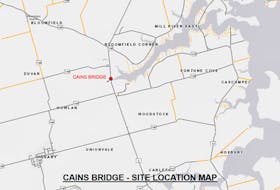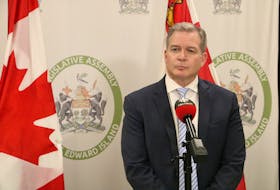A research team has discovered that Prince Edward Island is exporting more than just potatoes.
It turns out that 95 per cent of the nitrates that are emptying into the Northumberland Strait are coming from this province. And of these, 91 per cent are coming from the Island's agriculture industry.
The research is the result of the work of a group of scientists and a host of grad students who have been studying how human activities on land are affecting waterways in the region, including the Northumberland Strait.
The scientists received $600,000 after putting out a call for proposals to the Northumberland Strait-Environmental Monitoring Partnership under the Canadian Water Network.
"Nobody had ever gone out and said what province is all the nutrients coming from and looked at all three provinces (New Brunswick, Nova Scotia and P.E.I.) together and what goes into the Northumberland (Strait) on a regional basis," said Mike R. van den Heuvel, director of the Canadian Rivers Institute located at the University of Prince Edward Island.
The research took place over a four-year period. They found high levels of nitrates coming from P.E.I. farms. Van den Heuvel said 57 per cent of the nitrates from the agriculture industry is coming from potato production.
When asked about the study’s findings, P.E.I. Potato Board general manager Greg Donald said farmers are always looking for ways to improve the industry and the environment.
"Is there an issue with nitrates? Absolutely. Is it getting better? Absolutely."
Donald refers to a graph on the Department of Communities, Land and Environment website on nitrate concentrations in 10 Island streams. The graph shows that since 2010, the nitrate levels in most of the streams are on the decline.
"There is a lot of efforts around looking at different cover crops and also fall seeded cover crops, and those are all geared towards soil management, erosion control and also managements of nitrates."
Van den Heuvel says the research also shows the effects of nutrients and sediments in estuaries. An estuary is an enclosed body of water with a mix of fresh and salt water.
There are hundreds of estuaries on P.E.I., and every year nitrates cause more than 20 to become anoxic, meaning depleted of oxygen.
This affects everything from mussels, oysters and eels.
Van den Heuvel said the solution is to be more serious about reaching nutrient goals.
"There are a number of things we can do," said van den Heuvel, "things like reducing agriculture area, better crops and better nutrient management."
Donald said potato farmers are working to do just that, noting the board is one of the partners under the 4R Nutrient Stewardship system.
"We invest and continue to invest in good science-based information, particularly when it comes to the environment,” Donald said.
The 4R system applies the right source, right place, right rate and right time to ensure best practices so fertilizers don't find their way into the groundwater on P.E.I.
"We are very much about improving things and understanding things better, getting the facts and then what can we do to improve it,” said Donald.
Besides examining nitrates, the scientists looked at sediment in estuaries.
"With nitrogen, we knew already to some extent how much was coming off and that there was a nitrogen issue....In terms of sediment, we had nothing."
Sediment happens when contaminants, including road construction debris, go into the waterways.
"Sediment is something we all know happens, everybody knows the rivers turn red, so it is an issue."
The researchers have established a monitoring plan so that watershed groups, as well as provincial and federal governments, have a foundation to better understand the environmental quality.
Solutions to some of these human activities include planting more trees, not farming on slopped land and having more diversification of agriculture.
Their work for this project concludes March 31.
A research team has discovered that Prince Edward Island is exporting more than just potatoes.
It turns out that 95 per cent of the nitrates that are emptying into the Northumberland Strait are coming from this province. And of these, 91 per cent are coming from the Island's agriculture industry.
The research is the result of the work of a group of scientists and a host of grad students who have been studying how human activities on land are affecting waterways in the region, including the Northumberland Strait.
The scientists received $600,000 after putting out a call for proposals to the Northumberland Strait-Environmental Monitoring Partnership under the Canadian Water Network.
"Nobody had ever gone out and said what province is all the nutrients coming from and looked at all three provinces (New Brunswick, Nova Scotia and P.E.I.) together and what goes into the Northumberland (Strait) on a regional basis," said Mike R. van den Heuvel, director of the Canadian Rivers Institute located at the University of Prince Edward Island.
The research took place over a four-year period. They found high levels of nitrates coming from P.E.I. farms. Van den Heuvel said 57 per cent of the nitrates from the agriculture industry is coming from potato production.
When asked about the study’s findings, P.E.I. Potato Board general manager Greg Donald said farmers are always looking for ways to improve the industry and the environment.
"Is there an issue with nitrates? Absolutely. Is it getting better? Absolutely."
Donald refers to a graph on the Department of Communities, Land and Environment website on nitrate concentrations in 10 Island streams. The graph shows that since 2010, the nitrate levels in most of the streams are on the decline.
"There is a lot of efforts around looking at different cover crops and also fall seeded cover crops, and those are all geared towards soil management, erosion control and also managements of nitrates."
Van den Heuvel says the research also shows the effects of nutrients and sediments in estuaries. An estuary is an enclosed body of water with a mix of fresh and salt water.
There are hundreds of estuaries on P.E.I., and every year nitrates cause more than 20 to become anoxic, meaning depleted of oxygen.
This affects everything from mussels, oysters and eels.
Van den Heuvel said the solution is to be more serious about reaching nutrient goals.
"There are a number of things we can do," said van den Heuvel, "things like reducing agriculture area, better crops and better nutrient management."
Donald said potato farmers are working to do just that, noting the board is one of the partners under the 4R Nutrient Stewardship system.
"We invest and continue to invest in good science-based information, particularly when it comes to the environment,” Donald said.
The 4R system applies the right source, right place, right rate and right time to ensure best practices so fertilizers don't find their way into the groundwater on P.E.I.
"We are very much about improving things and understanding things better, getting the facts and then what can we do to improve it,” said Donald.
Besides examining nitrates, the scientists looked at sediment in estuaries.
"With nitrogen, we knew already to some extent how much was coming off and that there was a nitrogen issue....In terms of sediment, we had nothing."
Sediment happens when contaminants, including road construction debris, go into the waterways.
"Sediment is something we all know happens, everybody knows the rivers turn red, so it is an issue."
The researchers have established a monitoring plan so that watershed groups, as well as provincial and federal governments, have a foundation to better understand the environmental quality.
Solutions to some of these human activities include planting more trees, not farming on slopped land and having more diversification of agriculture.
Their work for this project concludes March 31.








